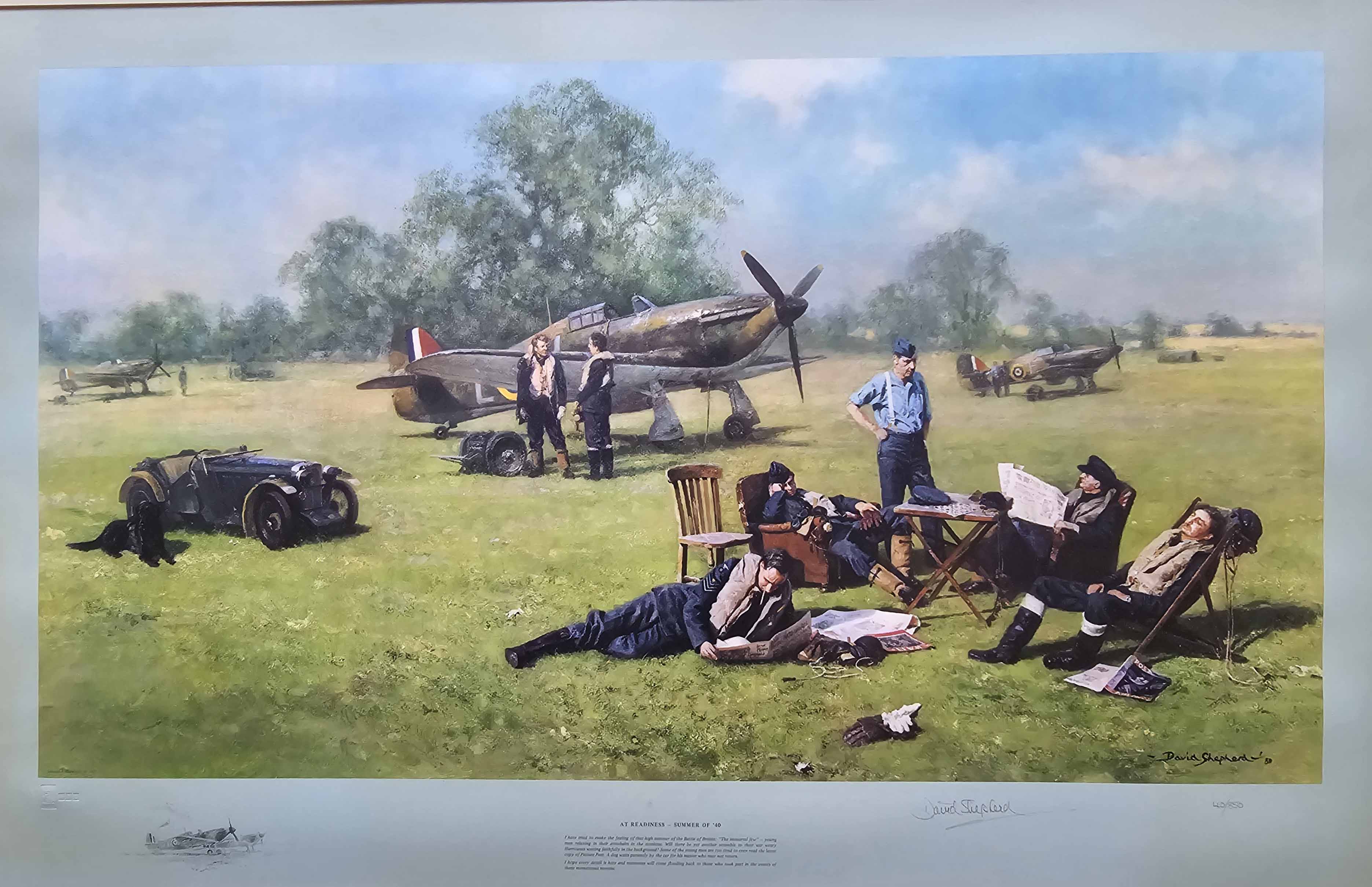At Readiness-Summer of '40
David Shepherd
CBE OBE FRSA FGRA
David Shepherd
Home Page
Elephants
Signed Prints
Big Cats
Signed Prints
World Wildlife
Signed Prints
British Wildlife
and Landscapes
Signed Prints
Original
Paintings
and Drawings
Aviation
Signed Prints
Military
Signed Prints
Portraits
Signed Prints
Steam Trains
Signed Prints
About us
Contact us

"At Readiness-Summer of '40"
Signed Limited Edition
Date of publication April 1981
Image Size:- 32" x 17.5"
Neil Cameron, Baron Cameron of Balhousie
Marshal of the Royal Air Force Neil Cameron, Baron Cameron of Balhousie, KT, GCB, CBE, DSO, DFC (8 July 1920 - 29 January 1985) was a senior officer in the Royal Air Force.
He fought in the Second World War as a fighter pilot taking part in the Battle of Britain,
the Battle of Alam el Halfa, the First Battle of El Alamein and the Second Battle of El Alamein and then in operations in Burma.
He served as Chief of the Air Staff in the late 1970s advising the British Government on the reinforcement of the British garrison in Belize
which was under threat from Guatemala at the time.
He also served as the Chief of the Defence Staff at the end of the 1970s in which role he secured pay comparability for services personnel involved in civil support
during the firemen's strike, visited the People's Republic of China and lectured extensively on the Soviet air threat.
Sir Douglas Bader
Group Captain Sir Douglas Robert Stuart Bader, CBE, DSO & Bar, DFC & Bar, DL, FRAeS (21 February 1910 - 5 September 1982) was a Royal Air Force flying ace during the Second World War.
He was credited with 22 aerial victories, four shared victories, six probables, one shared probable and 11 enemy aircraft damaged.
Bader joined the RAF in 1928, and was commissioned in 1930. In December 1931, while attempting some aerobatics, he crashed and lost both his legs.
Having been on the brink of death, he recovered, retook flight training, passed his check flights and then requested reactivation as a pilot.
Although there were no regulations applicable to his situation, he was retired against his will on medical grounds.
After the outbreak of the Second World War in 1939, however, Douglas Bader returned to the RAF and was accepted as a pilot.
He then took part in the Battle of Britain and became a friend and supporter of Air Vice Marshal Trafford Leigh-Mallory and his 'Big Wing' experiments.
The Spitfire is the most famous plane of World War Two.
Its groundbreaking design and superior specifications gave the British a decisive advantage fighting the Luftwaffe in the Battle of Britain.
But early models were often cruelly exposed in head-to-head duels with the enemy.
It was only after multiple improvements that the Spitfire's winning combination of speed, manoeuvrability and firepower turned it into a formidable killing machine and a much loved British icon.
In 1940 Hitler sent 2,600 Luftwaffe fighters and bombers to destroy the Royal Air Force.
At the start of the battle the RAF only had 640 fighters, Hurricanes and Spitfires,
and German commander Herman Goering confidently predicted victory would only take a few days.
Britain stepped up the production of fighter planes, building them faster than Germany.
The Hurricanes, with their sturdy frames, took on the bombers. The Mark I Spitfires, with their superior speed and agility, were sent up to shoot down German fighters.
By the end of the battle the better organised RAF had defeated the Luftwaffe and downed 1,887 German planes.
The RAF lost 1,023 planes.
The tide of the war started to turn. Britain was now a launch pad for future attacks on Germany.
© S & W © David Shepherd
Back to David Shepherd prints for sale.
